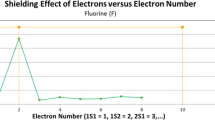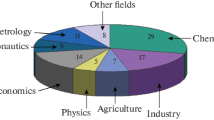Abstract
In the Periodic Tables the transition from atoms to double-charged cations is accompanied by alterations in the composition of s and p blocks and reciprocal location of blocks, as well as by changes in the composition and length of periods. We have previously described the relationship between the atom properties and the total number of differentiating electrons. This paper demonstrates that, despite the above transition-related alterations, this relationship is also valid for the description of the properties of double-charged cations. This can be exemplified by the dependence of the ionization energy on the total number of p electrons in p block, d electrons in d block, and f electrons in f block. Furthermore, a single periodic equation is sufficient for the description of properties of all of double-charged cations from each block.






Similar content being viewed by others
Notes
Actually, the electronic configurations are as follows (Kramida et al. 2011): K2+, 3s 23p 5; Ca2+, 3s 23p 6; Sc2+, 3s 23p 63d 1. Therefore in going K2+–Ca2+–Sc2+ first the filling of 3p subshell ends, then, without deviating from the regularity, a 3d electron appears. Only on filling the 3d-subshell in Zn2+ (3s 23p 63d 10) an electron arrives on the fourth shell in Ga2+ (3d 104s 1), and the fourth period begins.
The notion “ionization” with respect to the transformation of one ion into another seems not appropriate but it is commonly used.
References
Bent, H.: New Ideas in Chemistry from Fresh Energy for the Periodic Law. AuthorHouse, Bloomington (2006)
Buchachenko, A.L.: Compressed atoms. J. Phys. Chem. Sect. B. 105, 5839–5846 (2001)
Chistyakov, V.M.: “Secondary periodicity of Biron” in secondary d-subgroups of the short periodic table. Zh. Obshch. Khim. 38, 209–210 (1968). (See the abstract below)
Connerade, J.P., Dolmatov, V.K., Lakshmi, P.A.: The filling of shells in compressed atoms. J. Phys. B: At. Mol. Opt. Phys. 33, 251–264 (2000)
Emsley, J.: Nature’s Building Blocks: An A-Z Guide to the Elements. Oxford University Press, Oxford (2003)
Filippov, G.G., Gorbunov, A.I.: Four “correct” forms of the periodic system of elements. Zh. Fiz. Khim. 67, 1809–1812 (1993). (See the abstract below)
Godovikov, A.A.: Periodic System of D.I. Mendeleev and Force Characteristics of Elements. Nauka, Novosibirsk (1981) [in Russian]. (See the abstract below)
Grigorovich, V. K.: Electronic Structure and Thermodynamics of Ferrous Alloys. Nauka, Moscow (1970) [in Russian]. (See the abstract below)
Heyes, S.J.: Which Elements are d-Block or f-Block? http://www.chem.ox.ac.uk/icl/heyes/lanthact/I5.html (1997–1998). Accessed 22 July 2012
Imyanitov, N.S.: Mathematical description of dialectic regular trends in the periodic system. Russ. J. Gen. Chem. 69, 509–517 (1999a)
Imyanitov, N.S.: Equations of new type for the description and simple calculation of electronic parameters of the neutral ligands of ElRn type. Russ. J. Coord. Chem. 25, 293–299 (1999b)
Imyanitov, N.S.: Dialectic functions for description and prediction of proton affinity and basicity in gas phase. Russ. J. Org. Chem. 37, 1196–1204 (2001a)
Imyanitov, N.S.: Inductive effects of ligands or substituents based on any of the sp elements. Russ. J. Coord. Chem. 27, 823–829 (2001b)
Imyanitov, N.S.: Modification of various functions for description of periodic dependences. Russ. J. Coord. Chem. 29, 46–52 (2003)
Imyanitov, N.S.: New basis for describing periodicity. Russ. J. Gen. Chem. 80, 65–68 (2010)
Imyanitov, N.S.: Application of a new formulation of the periodic law to predicting the proton affinity of elements. Russ. J. Inorg. Chem. 56, 745–748 (2011a)
Imyanitov, N.S.: The Periodic Law. Formulations, equations, graphic representations. Russ. J. Inorg. Chem. 56, 2183–2200 (2011b)
Jensen, W.B.: The positions of lanthanum (actinium) and lutetium (lawrencium) in the periodic table. J. Chem. Educ. 59, 634–636 (1982)
Jensen, W.B.: Misapplying the Periodic Law. J. Chem. Educ. 86, 1186 (2009)
Korableva, T.P., Korol’kov, D.V.: Theory of the Periodic System. Izd-vo SPbU, St. Petersburg (2005) [in Russian]. (See the abstract below)
Kramida, A., Ralchenko, Y., Reader, J., NIST ASD Team. NIST Atomic Spectra Database (ver. 5.0), [Online]. National Institute of Standards and Technology, Gaithersburg, MD. http://physics.nist.gov/asd (2011). Accessed 1 March 2013
Scerri, E.R.: A Very Short Introduction to the Periodic Table. Oxford University Press, Oxford (2011)
Scerri, E.: Mendeleev’s periodic table is finally completed and what to do about group 3? Chem. Int. July-Aug, 28–31(2012)
Shchukarev, S.A.: Inorganic Chemistry. Vysshaya Shkola, Moscow (1970), Vol. 1 [in Russian]
Shchukarev, S.A.: Inorganic Chemistry. Vysshaya Shkola, Moskow (1974), Vol. 2 [in Russian]
Shchukarev, S.A.: New views of D.I. Mendeleev’s system. I. Periodicity of the stratigraphy of atomic electronic shells in the system, and the concept of Kainosymmetry. Zh. Obshch. Khim. 47, 246–259 (1977). (See the abstract below)
Wang, S.-G., Schwarz, W.H.E.: Icon of chemistry: the periodic system of chemical elements in the new century. Angew. Chem. Int. Ed. 48, 3404–3415 (2009)
Author information
Authors and Affiliations
Corresponding author
Key contents of the sources published in Russian
Key contents of the sources published in Russian
Chistyakov, V. M.: “Secondary Periodicity of Biron” in Secondary d - Subgroups of the Short Periodic Table. Zh. Obshch. Khim. 38, 209 – 210 (1968)
Radii of free atoms calculated by means of the Dirac equation and the sums of the first 2 ionization potentials of these atoms, i.e. the parameters of the outer electrons of d elements, were shown to be periodic functions of atomic numbers in each such d subgroup.
The atomic radii were always greatest for the mid-elements in the subgroups: Sc–Y–Lu, Ti–Zr–Hf, V–Nb–Ta, Cr–Mo–W, Mn–Tc–Re, Fe–Ru–Os, Cu–Ag–Au, Zn–Cd–Hg; however, the atomic radii increased steadily in the subgroup Sc–Y–La.
The values of the sums of the first two ionization potentials in the following subgroups were minimal for the mid-elements in the subgroups: Sc–Y–Lu, Ti–Zr–Hf, V–Nb–Ta, Cr–Mo–W, Mn–Tc–Re, Fe–Ru–Os, Cu–Ag–Au, Zn–Cd–Hg; however, sums of the first two ionization potentials decreased steadily in the subgroup Sc–Y–La.
Filippov, G.G., Gorbunov, A.I.: Four “Correct” Forms of the Periodic System of Elements. Zh. Fiz. Khim. 67, 1809 – 1812 (1993)
The configuration of the periodic system of elements is defined as a sequence of s, p, d and f vector-columns. The blocks may be subject to permutation, and the number of the possible mutual locations of four blocks (s, p, d, f) is 24. However the Periodic Law determines that only four “correct” configurations are allowable since only in these positions do the variations in the nuclear charge of the elements remain monotonic. In these configurations the positions of the blocks are: s–f–d–p, f–d–p–s, d–p–s–f and p–s–f–d.
Each of these configurations is complementary to the other ones in explaining the properties of the elements and their compounds. One of these variants, s–f–d–p, is the conventional form, whose schematic representation is reflected in Table 1 (see above).
Godovikov, A. A.: Periodic System of D.I. Mendeleev and Force Characteristics of Elements. Nauka, Novosibirsk (1981) [in Russian]. 94 p, 15 figs, 15 tabs.
This book contains chapters discussing principles of element disposition in the System, properties of atoms and ions, similarities and differences in the properties of the elements.
Grigorovich, V. K.: Electronic Structure and Thermodynamics of Ferrous Alloys. Nauka, Moscow (1970) [in Russian]. 292p., 256 refs, 147 figs, 30 tabs.
Brief description of the chapter “Periodic system for the elements at high pressure and metallic state”.
The experiments and calculations show that at 103–104 atmospheres the electrons from the outer subshells go down to the unoccupied inner shells: 4s → 3d, 5s → 4d, 6s → 5d, 7s → 6d and 5d → 4f, 6d → 5f. However when the outer subshells are fully populated (s 2, p 6, d 10, f 14), the transfer of electrons to the unoccupied inner subshells requires millions of atmospheres.
With increasing pressure Cs, Fr, Ba, Ra go from the s block to d and further into f block. Ag–Xe become f elements. Ultra-high pressures result in “ideal” filling with the lack of empty inner subshells. Periodic tables are designed for pressures of 104–106 atmospheres and 50–100 million atmospheres.
Korableva, T.P., Korol’kov, D.V.: Theory of the Periodic System. Izd-vo SPbU, St. Petersburg (2005) [in Russian] 173 p., 61 refs, 15 figs, 11 tabs.
Textbook for chemical university faculties containing the following chapters: Periodic system of elements as an ordered set, Quantum–mechanical theory of the canonical structure of the Periodic system of chemical elements, Superheavy elements in the Periodic system, 2 “camps” of chemical elements, Mendeleev rule of parity and the limits of its application, Chemistry of the beginner elements of s-, p-, d-, f-families, Secondary periodicity, Additional periodicity, Individuality of chemical elements, New approaches in the theory of Periodic system, Novel atoms and their position in the Periodic system, Periodic system and valence of the atoms within molecules.
Shchukarev, S. A.: New Views of D.I. Mendeleev’s System. I. Periodicity of the Stratigraphy of Atomic Electronic Shells in the System, and the Concept of Kainosymmetry. Zh. Obshch. Khim. 47, 246 – 259 (1977)
A review with six refs on the concept of kainosymmetry in the periodic system and its relation to periodicity of various atomic properties, e. g. valence, ionization potential, reactivity, bond strength, orbital radii.
The English version has been published by Plenum Publishing Corporation, New York.
A detailed abstract in English is given in Bent 2006, p. 176 (see above, References)
Rights and permissions
About this article
Cite this article
Imyanitov, N.S. Adequacy of the new formulation of the Periodic Law when fundamental variations occur in blocks and periods. Found Chem 16, 235–247 (2014). https://doi.org/10.1007/s10698-014-9204-x
Published:
Issue Date:
DOI: https://doi.org/10.1007/s10698-014-9204-x




